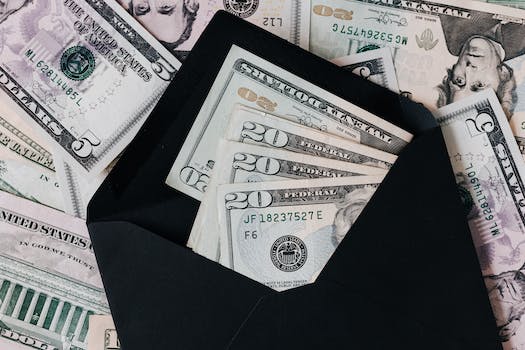How To Save Money Per Month
Introduction

Introduction: Saving money is an essential aspect of financial planning. It helps you to achieve your financial goals and secure your future. However, saving money can be challenging, especially if you have a limited income or high expenses. In this article, we will discuss some practical tips on how to save money per month. These tips will help you to reduce your expenses, increase your savings, and achieve your financial goals.
10 Simple Ways to Cut Your Monthly Expenses
Saving money is a goal that many people have, but it can be difficult to know where to start. Fortunately, there are many simple ways to cut your monthly expenses and start saving money. Here are 10 tips to help you save money per month.
1. Create a budget
The first step to saving money is to create a budget. This will help you see where your money is going and where you can cut back. Start by listing all of your monthly expenses, including rent or mortgage, utilities, groceries, and entertainment. Then, compare your expenses to your income and see where you can make cuts.
2. Cut back on eating out
Eating out can be expensive, so try to cut back on how often you do it. Instead, cook meals at home and pack your lunch for work. This can save you hundreds of dollars per month.
3. Cancel subscriptions
Do you have subscriptions to magazines, streaming services, or other monthly services that you don’t use? Cancel them and save yourself some money.
4. Use coupons and discounts
Before making a purchase, look for coupons and discounts. You can find them online or in newspapers and magazines. This can save you a significant amount of money over time.
5. Buy generic brands
Generic brands are often just as good as name-brand products, but they are much cheaper. Try buying generic brands for groceries, toiletries, and other household items.
6. Use public transportation
If you live in an area with public transportation, consider using it instead of driving. This can save you money on gas, car maintenance, and parking fees.
7. Cut back on energy usage
Cutting back on your energy usage can save you money on your monthly utility bills. Turn off lights and electronics when you’re not using them, and adjust your thermostat to save on heating and cooling costs.
8. Shop around for insurance
Insurance can be a significant expense, but you can save money by shopping around for the best rates. Compare prices from different providers and choose the one that offers the best coverage for the lowest price.
9. Buy used items
Buying used items can save you money on everything from clothing to furniture. Check out thrift stores, consignment shops, and online marketplaces to find great deals.
10. Negotiate bills
Finally, don’t be afraid to negotiate your bills. Call your service providers and ask if they can offer you a better rate. You may be surprised at how much money you can save.
In conclusion, there are many simple ways to cut your monthly expenses and save money. By creating a budget, cutting back on eating out, canceling subscriptions, using coupons and discounts, buying generic brands, using public transportation, cutting back on energy usage, shopping around for insurance, buying used items, and negotiating bills, you can save hundreds of dollars per month. So start implementing these tips today and watch your savings grow!
Creating a Budget: A Step-by-Step Guide
Saving money is a goal that many people have, but it can be difficult to know where to start. One of the most effective ways to save money is by creating a budget. A budget is a plan for how you will spend your money each month. By creating a budget, you can identify areas where you can cut back on spending and save more money. In this article, we will provide a step-by-step guide to creating a budget that will help you save money each month.
Step 1: Determine Your Income
The first step in creating a budget is to determine your income. This includes any money you earn from your job, as well as any other sources of income such as rental income or investment income. Make sure to include all sources of income so that you have an accurate picture of your finances.
Step 2: List Your Expenses
The next step is to list all of your expenses. This includes both fixed expenses, such as rent or mortgage payments, and variable expenses, such as groceries or entertainment. Make sure to include all expenses, no matter how small, so that you have a complete picture of your spending.
Step 3: Categorize Your Expenses
Once you have listed all of your expenses, it is time to categorize them. This will help you identify areas where you can cut back on spending. Common categories include housing, transportation, food, entertainment, and debt repayment. You may also want to create subcategories within each category to further break down your expenses.
Step 4: Determine Your Priorities
Now that you have categorized your expenses, it is time to determine your priorities. This means deciding which expenses are essential and which are discretionary. Essential expenses are those that you must pay in order to maintain your basic needs, such as housing and food. Discretionary expenses are those that are not essential, such as entertainment or dining out.
Step 5: Set Your Budget
Once you have determined your priorities, it is time to set your budget. This means deciding how much money you will allocate to each category of expenses. Make sure to set realistic goals that you can stick to. It is also important to leave some room in your budget for unexpected expenses or emergencies.
Step 6: Track Your Spending
Now that you have created a budget, it is important to track your spending to make sure that you are sticking to it. This can be done using a spreadsheet or budgeting app. Make sure to update your budget regularly and adjust it as needed.
Step 7: Review Your Budget
Finally, it is important to review your budget regularly to make sure that it is still working for you. This means looking for areas where you can cut back on spending and finding ways to save more money. It is also important to celebrate your successes and stay motivated to continue saving money.
In conclusion, creating a budget is an effective way to save money each month. By following these seven steps, you can create a budget that works for you and helps you achieve your financial goals. Remember to be realistic and flexible, and don’t be afraid to make adjustments as needed. With a little effort and discipline, you can save money and achieve financial freedom.
The Benefits of Meal Planning and Grocery Shopping on a Budget
Are you tired of constantly feeling like you’re living paycheck to paycheck? Do you want to start saving money but don’t know where to begin? One simple and effective way to save money per month is by meal planning and grocery shopping on a budget.
Meal planning involves deciding what meals you will eat for the week or month ahead of time. This allows you to make a grocery list and only buy the necessary ingredients, avoiding impulse purchases and reducing food waste. By planning your meals, you can also take advantage of sales and discounts, which can save you money in the long run.
When grocery shopping on a budget, it’s important to have a plan in place. Start by setting a budget for your groceries and sticking to it. Look for deals and discounts, and consider buying generic or store-brand products instead of name-brand items. You can also save money by buying in bulk and freezing extra portions for later use.
Another way to save money on groceries is by shopping at discount stores or buying in-season produce. These options are often cheaper than shopping at high-end grocery stores or buying out-of-season produce. Additionally, consider using coupons or cashback apps to save even more money on your grocery bill.
Not only does meal planning and grocery shopping on a budget save you money, but it also has other benefits. By planning your meals, you can ensure that you are eating a balanced and healthy diet. This can lead to improved overall health and potentially save you money on healthcare costs in the long run.
Meal planning and grocery shopping on a budget can also save you time. By having a plan in place, you can avoid last-minute trips to the grocery store or ordering takeout, which can be both time-consuming and expensive. Additionally, by buying in bulk and freezing extra portions, you can save time on meal prep in the future.
If you’re new to meal planning and grocery shopping on a budget, it may seem overwhelming at first. However, there are many resources available to help you get started. There are countless meal planning apps and websites that can help you plan your meals and create a grocery list. Additionally, there are many blogs and social media accounts dedicated to sharing tips and tricks for grocery shopping on a budget.
In conclusion, meal planning and grocery shopping on a budget is a simple and effective way to save money per month. By planning your meals and sticking to a budget, you can avoid impulse purchases and take advantage of sales and discounts. Not only does this save you money, but it also has other benefits such as improved health and time savings. So why not give it a try and see how much money you can save?
How to Save Money on Utilities: Tips and Tricks
Saving money is a goal that many people have, but it can be difficult to know where to start. One area where you can make a significant impact on your monthly expenses is by reducing your utility bills. Here are some tips and tricks to help you save money on your utilities each month.
First, consider your energy usage. One of the easiest ways to save money on your utilities is to reduce your energy consumption. This can be done in a number of ways, such as turning off lights and electronics when they are not in use, using energy-efficient light bulbs, and adjusting your thermostat to a more energy-efficient temperature. You can also reduce your energy usage by using appliances and electronics that are Energy Star certified, which means they are designed to use less energy.
Another way to save money on your utilities is to reduce your water usage. This can be done by taking shorter showers, fixing leaks, and using a low-flow showerhead and toilet. You can also save water by only running your dishwasher and washing machine when they are full, and by using a rain barrel to collect water for your garden.
In addition to reducing your energy and water usage, there are other ways to save money on your utilities. For example, you can switch to a cheaper energy provider or negotiate a better rate with your current provider. You can also consider installing solar panels or a wind turbine to generate your own energy, which can significantly reduce your monthly bills.
Another way to save money on your utilities is to make your home more energy-efficient. This can be done by adding insulation to your walls and attic, sealing air leaks around doors and windows, and upgrading to energy-efficient windows and doors. You can also install a programmable thermostat, which will automatically adjust the temperature in your home based on your schedule.
Finally, consider using alternative sources of energy. For example, you can use a wood stove or fireplace to heat your home, or you can install a geothermal heating and cooling system. You can also use a solar water heater to heat your water, which can significantly reduce your monthly bills.
In conclusion, there are many ways to save money on your utilities each month. By reducing your energy and water usage, switching to a cheaper provider, making your home more energy-efficient, and using alternative sources of energy, you can significantly reduce your monthly bills. So why not start implementing these tips and tricks today and start saving money on your utilities?
The Importance of Saving for Emergencies and How to Start
Saving money is an essential part of financial planning. It is crucial to have a savings plan in place to prepare for emergencies, unexpected expenses, and future goals. Saving money per month can be challenging, but it is not impossible. In this article, we will discuss the importance of saving for emergencies and how to start.
The Importance of Saving for Emergencies
Emergencies can happen at any time, and they can be costly. Whether it is a medical emergency, a car breakdown, or a home repair, unexpected expenses can quickly drain your finances. Having an emergency fund can help you avoid going into debt or relying on credit cards to cover these expenses.
Experts recommend having at least three to six months’ worth of living expenses saved in an emergency fund. This may seem like a daunting task, but it is achievable with a little planning and discipline.
How to Start Saving
The first step to saving money per month is to create a budget. A budget will help you track your income and expenses and identify areas where you can cut back. Start by listing all your monthly expenses, including rent/mortgage, utilities, groceries, transportation, and entertainment. Then, subtract your expenses from your income to determine how much money you have left over each month.
Once you have a clear picture of your finances, you can start setting savings goals. Start small and aim to save a percentage of your income each month. Experts recommend saving at least 20% of your income, but any amount is better than nothing.
One way to make saving easier is to automate your savings. Set up a direct deposit from your paycheck into a savings account. This way, you won’t have to think about transferring money each month, and you’ll be less likely to spend it.
Another way to save money per month is to cut back on unnecessary expenses. Look for ways to reduce your monthly bills, such as canceling subscriptions you don’t use or negotiating lower rates for services like cable or internet. You can also save money by cooking at home instead of eating out, using coupons, and shopping for deals.
Finally, consider ways to increase your income. Look for side hustles or part-time jobs that can help you earn extra money each month. You can also sell items you no longer need or use to make some extra cash.
Conclusion
Saving money per month is essential for financial stability and preparedness. Start by creating a budget, setting savings goals, and automating your savings. Cut back on unnecessary expenses and look for ways to increase your income. Remember, saving money takes discipline and patience, but the rewards are worth it. With a little effort, you can build an emergency fund and achieve your financial goals.
Maximizing Your Savings with Coupons and Cashback Apps
Saving money is a goal that many people have, but it can be difficult to achieve. However, there are ways to save money that are easy and effective. One way to save money is by using coupons and cashback apps. These tools can help you save money on your purchases and maximize your savings.
Coupons are a great way to save money on your purchases. You can find coupons in newspapers, magazines, and online. Many stores also offer coupons that you can use in-store or online. When you use a coupon, you can save money on the item you are purchasing. This can add up over time and help you save a significant amount of money.
Cashback apps are another great way to save money. These apps allow you to earn cashback on your purchases. You can use these apps to earn cashback on purchases you make in-store or online. Some apps even offer cashback on purchases you make at restaurants or other businesses. When you use a cashback app, you can earn money back on your purchases, which can help you save money over time.
To maximize your savings with coupons and cashback apps, there are a few things you can do. First, you should always look for coupons before making a purchase. You can find coupons online or in-store. Some stores even offer coupons on their websites or through their mobile apps. By using coupons, you can save money on your purchases and maximize your savings.
Second, you should always use a cashback app when making a purchase. There are many cashback apps available, so it is important to find one that works for you. Some apps offer higher cashback rates than others, so it is important to compare different apps to find the best one for you. When you use a cashback app, you can earn money back on your purchases, which can help you save money over time.
Third, you should always look for deals and promotions. Many stores offer deals and promotions throughout the year. By taking advantage of these deals, you can save money on your purchases and maximize your savings. You can find deals and promotions online or in-store. Some stores even offer exclusive deals to their email subscribers or loyalty program members.
Fourth, you should always compare prices before making a purchase. You can use price comparison websites or apps to compare prices at different stores. By comparing prices, you can find the best deal and save money on your purchase. You can also use coupons and cashback apps to save even more money.
In conclusion, coupons and cashback apps are great tools for saving money. By using these tools, you can save money on your purchases and maximize your savings. To maximize your savings, you should always look for coupons, use a cashback app, look for deals and promotions, and compare prices before making a purchase. With these tips, you can save money and achieve your financial goals.
Investing in Your Future: Tips for Saving for Retirement
Saving money is a crucial aspect of financial planning. It is essential to have a budget and stick to it to ensure that you are not overspending. However, saving money can be challenging, especially when you have bills to pay and other expenses to take care of. But with the right mindset and a few tips, you can save money per month and invest in your future.
One of the best ways to save money per month is to create a budget. A budget helps you keep track of your expenses and income, and it allows you to allocate your money to the things that matter most. To create a budget, start by listing all your monthly expenses, including rent, utilities, groceries, and transportation. Then, subtract your expenses from your income to determine how much money you have left over. This leftover money is what you can use to save.
Another way to save money per month is to cut back on unnecessary expenses. This could mean canceling subscriptions you don’t use, eating out less, or finding cheaper alternatives for things you regularly buy. For example, instead of buying coffee every day, you could make your coffee at home. Small changes like these can add up and help you save money per month.
Investing in your future is also an essential aspect of saving money per month. One way to do this is to start saving for retirement. Retirement may seem far away, but it’s never too early to start planning for it. The earlier you start saving, the more time your money has to grow. There are several retirement savings options available, including 401(k)s, IRAs, and Roth IRAs. Talk to a financial advisor to determine which option is best for you.
Another way to invest in your future is to start an emergency fund. An emergency fund is a savings account that you can use to cover unexpected expenses, such as car repairs or medical bills. Having an emergency fund can help you avoid going into debt when unexpected expenses arise. Aim to save at least three to six months’ worth of living expenses in your emergency fund.
Investing in your future also means paying off debt. Debt can be a significant obstacle to saving money per month, as it can eat up a significant portion of your income. Make a plan to pay off your debt, starting with the debt with the highest interest rate. Once you’ve paid off your debt, you’ll have more money to put towards savings and investing in your future.
Finally, it’s essential to stay motivated when saving money per month. Saving money can be challenging, and it’s easy to get discouraged. However, keeping your goals in mind can help you stay motivated. Set specific, achievable goals for yourself, such as saving a certain amount of money per month or paying off a specific debt. Celebrate your successes along the way, and don’t be too hard on yourself if you slip up. Remember that saving money is a journey, and it takes time and effort to reach your goals.
In conclusion, saving money per month is essential for financial stability and investing in your future. Creating a budget, cutting back on unnecessary expenses, and investing in retirement and an emergency fund are all ways to save money per month. Paying off debt and staying motivated are also crucial aspects of saving money. With the right mindset and a few tips, you can save money per month and achieve your financial goals.
Conclusion
Conclusion: Saving money per month is a crucial aspect of financial planning. By creating a budget, tracking expenses, reducing unnecessary spending, and finding ways to increase income, individuals can save money and achieve their financial goals. It requires discipline and commitment, but the benefits of having a financial cushion and being able to afford the things that matter most are worth the effort.







